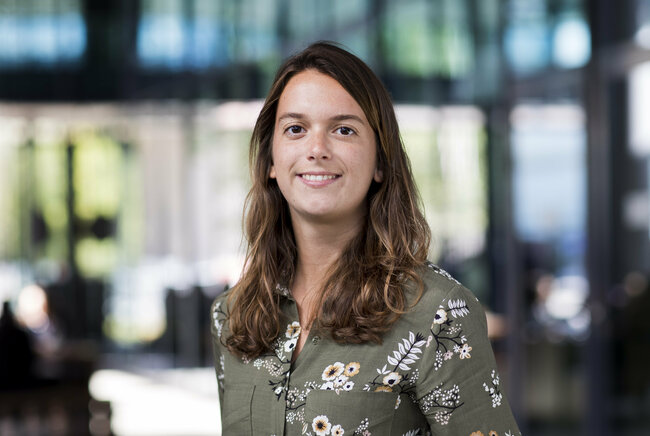Gender and age define success of biodegradable implants

Currently available implants intended for people with cardiovascular diseases consist of either donor material from animals or humans or synthetic implants and are therefore of limited availability. In situ tissue engineering attempts to create living blood vessels and heart valves to replace diseased tissues, which can grow along with the body. However, the results are still unpredictable. For her PhD research, Bente de Kort studied the processes involved in forming new cardiovascular tissue by the body in situ and stresses the importance of patient-specific characteristics, such as gender and age.
A large group of patients with cardiovascular diseases require cardiovascular implants, such as a heart valve prosthesis or a vascular bypass, to replace the damaged or diseased tissue. The demand for cardiovascular implants, for both blood vessels and heart valves, has been increasing for years due to the aging of the world population.
Currently available implants consists of either donor material (from animals or humans) or synthetic implants. While these are life-saving implants, they are not yet optimal for large patient groups due to limited availability (donor material), limited durability and inability to grow with the patient. The latter is especially a major problem for children with congenital heart defects who require prostheses.
To improve the quality of life for these patients, research is being conducted on what is known as in situ tissue engineering: an innovative method that attempts to create living blood vessels and heart valves to replace diseased tissues. The implant or scaffold is made of biodegradable synthetic polymers and can grow and adapt, or remodel, just like the tissue they replace.
After implanting, cells in the body will break down the implant or scaffold and form new tissue directly at the site of the diseased tissue, or in situ. The material therefore acts as a kind of mold for the cells to build the new tissue into. Eventually, this will create a new heart valve or blood vessel. This process starts with an inflammatory response caused by the implanted foreign-body synthetic scaffold, in which immune cells infiltrate the implant.
Unpredictable results
The immune cells, and specifically the macrophages, are essential for regulating the breakdown of the synthetic material and the rebuilding of the tissue. A proper balance between them ensures that the implants remain functional during the remodeling process.
Recent pre-clinical and small-scale clinical studies show that this technology appears suitable for patients, but results remain unpredictable due to variability in outcome. To ensure better predictability, more extensive knowledge of the processes involved in the formation of new cardiovascular tissue by the body in situ is needed.
De Kort specifically focused her research on the behaviour of macrophages and the patient-specific factors that can influence these processes.
Heart valve scaffolds in sheep
She found out that patient-specific factors, such as sex and age, were rarely considered in the design of animal studies and choice of animal model described in scientific literature. In addition, she discovered that the chosen animal species and the specific location of implantation matters.
To investigate variation due to location of implantation in in situ tissue engineering of heart valves, De Kort implanted heart valve scaffolds into the pulmonary circulation (pulmonary valve) and body circulation (aortic valve) in sheep. Analysis of these valves up to 24 and 12 months after implantation showed that in the aortic valves, fewer cells infiltrated resulting in minimal scaffold degradation and tissue formation, relative to the pulmonary valves.
In addition, De Kort saw a heterogeneous pattern of tissue formation in the different locations in a valve. These differences occur, she found out, due to the forces caused by blood flow, namely strain and shear stress, to which the scaffold is subjected. These forces are much higher in the body circulation compared to the pulmonary circulation.
Macrophage behaviour
De Kort then used models in the lab, in vitro, to investigate the influence of strain and patient factors sex and age on macrophage behaviour. She looked at the polarization, function and fusion of macrophages isolated from human donor blood. These macrophages were seeded in scaffolds, similar to the implants used, with different fiber diameters. When different strain levels were imposed, it was found that higher strain (14%) made the macrophages more inflammatory, regardless of the fiber diameter. Stretch (up to 10%) did not prevent macrophage fusion. However, De Kort observed that both macrophages and fused macrophages were oriented in the direction of stretch, suggesting that both cell types can sense and respond to the stretch.
Finally, De Kort saw that macrophages isolated from blood of female donors responded more strongly to the scaffold material compared to macrophages isolated from blood of male donors of the same age. Thereby, she saw no clear influence of estrogen levels on the function of the macrophages isolated from blood from women.
In her research, De Kort highlights the importance of considering implantation site and patient-specific characteristics, such as sex and age, during the study and development of in situ cardiovascular implants. Improved and more extensive in vitro and preclinical models should contribute to a better predictability of the outcome of in situ cardiovascular implants for all patient populations.
Title of PhD thesis: Cardiovascular in situ Tissue Engineering - Unraveling heterogeneity and variability
Supervisors: Carlijn Bouten and Anthal Smits